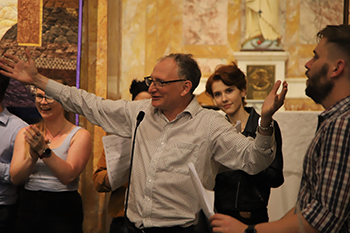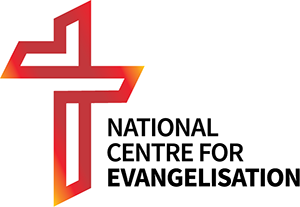At a recent weekly school Mass, we ran out of Communion hymns. The music director said, “You all know … from memory so please join in”.
I will not name the piece because I am not interested in the repertoire wars. The congregation sang the piece and the Mass proceeded seamlessly. The call to evangelise comes from Jesus himself. “Go therefore and make disciples of all nations, baptising them in the name of the Father and of the Son and of the Holy Spirit, and teaching them to obey everything that I have commanded you. And remember, I am with you always, to the end of the age.” These students will remember this memorised piece for the rest of their lives and they will forever be reminded that Jesus is with them.
 What is meant by using “liturgical music” for evangelisation? How does it differ from other uses of music for evangelisation? Since Vatican II, the difference is that liturgical music is usually music we sing together. Sacrosanctum Concilium – the Constitution of the Sacred Liturgy approved at the Second Vatican Council – states that “religious singing by the people is to be intelligently fostered so that … the voices of the faithful may ring out”. Of course, there is copious research to remind us that singing in groups improves both physical and mental health. Accordingly, despite COVID-19, community choirs have flourished. Astrid Jorgensen’s Pub Choir has become a national phenomenon.
What is meant by using “liturgical music” for evangelisation? How does it differ from other uses of music for evangelisation? Since Vatican II, the difference is that liturgical music is usually music we sing together. Sacrosanctum Concilium – the Constitution of the Sacred Liturgy approved at the Second Vatican Council – states that “religious singing by the people is to be intelligently fostered so that … the voices of the faithful may ring out”. Of course, there is copious research to remind us that singing in groups improves both physical and mental health. Accordingly, despite COVID-19, community choirs have flourished. Astrid Jorgensen’s Pub Choir has become a national phenomenon.
While it is easy to argue the mental and physical health reasons for community singing, how does it help evangelisation? Readers may have heard it said that those who “sing once pray twice”, but why does Sacrosanctum Concilium place so much importance on singing by the people? In a very moving workshop about singing in church, Canadian Mennonite conductor Tony Funk stressed the importance of learning religious music deeply and from memory so that the songs come to us in good times and in times of trial. Of course, God comes to us as we sing the songs. As an accredited lecturer in the Australian Kodaly music teaching method, I can attest that the best way to powerfully internalise a concept is to sing it. A powerful way to spread the faith is to sing it and live it.
With about one in five students in Australia attending Catholic schools, employing leaders of sacred song is essential. The Vatican document Musicam Sacram demands that “the formation of the whole people in singing, should be seriously and patiently undertaken … even from the first years of education in elementary schools” and “one must take particular care that the necessary ministers are obtained and that these are suitable, and that the active participation of the people is encouraged”.
These music ministers are to sing with people, not to them. At St Laurence’s, liturgical music is led by a choir of 150, not a solo singer. Music lessons are compulsory until the end of year 7, and every child sings in every lesson. In this way, when the Mass is sung, it is the voice of the assembly, students and staff together, which is paramount. Similarly, in my parish, it has been a simple matter to find mutually acceptable music that can be shared by our primary school, local secondary schools and the parish congregations. I know that a shared repertoire has been achieved by other communities in our Archdiocese.
Often, sacred music is the only music that people have in common. Currently, my year 7 music class is undertaking an analysis task of music of their choosing. They have chosen pieces from death metal to Vivaldi. They share almost no music in common. Religious music becomes the shared song of our school community, which is why it is commonly sung at sporting events, on bus trips and at parties. Surely the thundering out of sacred music by the crowd at a sporting match or on a social occasion counts as evangelisation.
I often hear people say, “My people won’t sing”; I respond, “Give them a chance”. Singing is easily learned. It used to be taught in families and still is in many non-Western cultures. If we are to re-evangelise those from a Western cultural background, we need to re-teach them to sing together.
There are also some basic barriers to group singing which must be dealt with.
- People can’t sing what they don’t know. Continually changing repertoire disempowers the group. We don’t change the music for Happy Birthday every year, nor does Liverpool Football Club change You’ll Never Walk Alone. Usually, musicians are bored before the singers, especially now with more transient congregations and less regular attendance at liturgies. At St Laurence’s the year 12s learn a song at leadership camp and teach it to the school at the start of the new year, so most students learn a new song each year. However, every year, 400 new students must learn all of the songs from scratch as well as the responses to the Mass itself. Accordingly, we have a full school Mass practice for a period before every full school Mass, and now it is the students who lead the unchurched parents in the responses.
- People can’t sing notes they haven’t got. Music needs to have a manageable range and be in a key that is suitable to the majority.
- People can’t sing if they can’t tell when the next note is going to happen. Syncopated rhythms can be fine if they are repeated, but the beat, pulse and rhythm of the music must be strong, steady and clear to all. This is essential regardless of the style or genre of the music. Even non-metrical chant can be sung with consistency and clarity.
I know from long experience that if we enable people to sing and support them in doing so, they love it and they love what they sing, regardless of style or genre. Janice Chapman says, “We are walking musical instruments and singing is our birthright”. We should empower Catholics to sing the faith to welcome others into the joy of the people of God.
Dr Anthony Young is the Assistant Head of Faculty – Music, at St Laurence’s College, South Brisbane, and a member of the Australian Catholic Bishops Conference’s National Liturgical Music Council.
Image: Supplied
Words: Dr Anthony Young
Further Reading
Dyball, Fiona (2021). Celebrating Liturgy in Schools: Catholic Identity in Song.
The National Schools Singing Program (2022). Why Singing?
Seely, Andrew (2021). Why Catholic Schools Should be Communities of Sacred Song.
Calabrese, Alfred (2018). Repetition at the School Mass: "Do it again!"
Wald-Fuhrmann, Melanie; Boenneke, Sven; Vroegh, Thijs; and Dannecker, Klaus Peter (2020). “He Who Sings, Prays Twice”? Singing in Roman Catholic Mass Leads to Spiritual and Social Experiences That Are Predicted by Religious and Musical Attitudes in Frontiers in Psychology.



